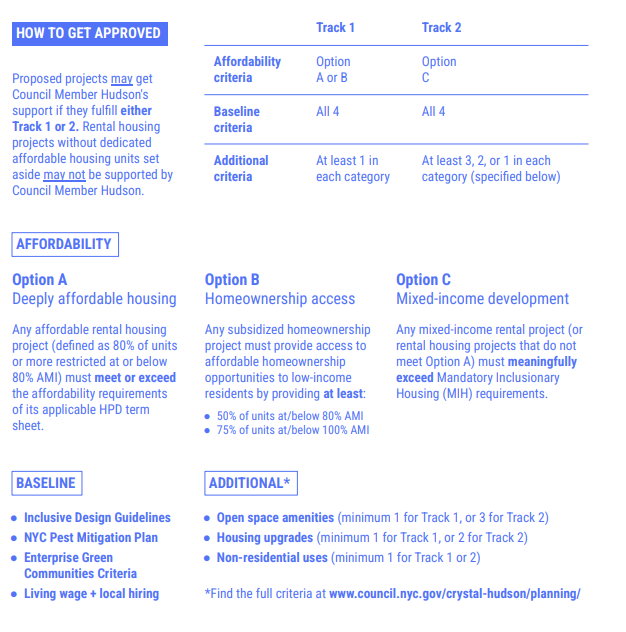Like participatory budgeting, but for land use
Overview
The current land use decision-making process in New York City is deeply flawed. Community members often do not have a meaningful role in shaping the outcomes of a new building or development project. These conditions do not work towards fulfilling the long-term needs or aspirations of community members.
Our office is leading a new approach, entitled Planning Together for Our Future, to ensure that community priorities are integrated in land use processes in District 35. The framework below was designed and developed by Hester Street. It was commissioned by the New York City Council through discretionary funding.
Framework Overview
Current land use decisions are made piecemeal. Developers can get approvals to change density and height restrictions to build larger, taller developments. They can also change the zoning of a lot or area. Many of these decisions don’t consider the surrounding area or incorporate resident input; instead these isolated decisions can hurt communities and displace long-standing residents.
NYC’s Uniform Land Use Review Procedure (or ULURP) is the existing land use decision-making process to change zoning rules for a specific lot or area. It was developed in 1975 to prevent urban renewal-style razing of neighborhoods and to engage communities. However, it has become convoluted and inaccessible for many. Today, ULURP encourages one-off development and enables real estate speculation that can rapidly transform neighborhoods. The current process favors real estate developers and jeopardizes the wellbeing and livelihood of low-income and working class residents, especially in Black and Brown neighborhoods.
So how do you create a comprehensive understanding of the district, informed by community input? And how can this understanding drive sustainable, equitable development? This framework incorporates findings from citywide data and community engagement across District 35’s neighborhoods to inform future development decisions by Council Member Hudson.
Council Member Hudson provided funded to the non-profit organization Hester Street to understand:
- Current conditions in District 35
- Residents’ lived experiences
- Community priorities related to physical and social infrastructure (e.g. housing, open space, education, food access)
Hester Street used a mixed-method approach to showcase shifting demographics and to provide awareness around District 35 disparities in livability.
Hester Street developed a strategic engagement process to inform future development in District 35. The community engagement process was designed to understand community needs and priorities on a variety of land use issues. Data collection methods included a district-wide survey, public meetings with engagement activities, focus groups, canvassing, and more. Engagement events and outreach took place throughout the district to ensure that opportunities for public participation were accessible to a wide variety of stakeholders and residents The engagement strategy was nimble to address gaps along the way. For example, special efforts were made to reach Crown Heights residents due to lower initial participation in the survey.
D35 Framework
The findings from the district survey will inform future development in District 35, ensuring new development meets community needs. Council Member Hudson will evaluate new development proposed through ULURP using the following framework.
This community-driven approach to land-use planning in NYC is the first of its kind and seeks to inspire similar efforts in other Council Districts.
Based on community feedback, the Council Member will support development projects that:
- Exceed the minimum requirements for affordable housing in order to provide housing that is affordable to residents living in each neighborhood (to rent and own)
- Meet a baseline of providing safe, healthy, accessible, and sustainable places to live
- Provide fair compensation to workers and support a local workforce
- Provide amenities that address neighborhood disparities through the design and programming of open space, housing units, and non-residential uses
Proposed projects will considered for support by Council Member Hudson if they fulfill either Track 1 or Track 2.
- Track 1: Projects that prioritize the affordable housing needs of the neighborhood (affordability option A or B) must meet all 4 baseline criteria and at least 1 additional criteria in each category.
- Track 2: Projects pursuing affordability option C must meet all 4 baseline criteria and a specified minimum of additional criteria in each category.

Affordability Criteria
Option A: Deeply affordable housing
Affordable housing developers should maximize the production of deeply affordable units in accordance with the household incomes at the local, neighborhood level.
Any dedicated affordable rental housing project (defined as ≥80% of units restricted at or below 80% AMI) must meet or exceed the affordability requirements of its applicable “term sheet.”
Projects seeking financing through applicable HPD programs (e.g. Extremely Low + Low-Income Affordability – ELLA, Senior Affordable Rental Apartments – SARA, Supportive Housing Loan Program – SHLP)* are encouraged to contact the Council Member’s office to discuss how affordable and/or supportive housing may be maximized on site to address local needs.
Option B: Access to homeownership
Affordable homeownership opportunities are rare but highly desired in this community.
Any subsidized homeownership project must provide access to affordable homeownership opportunities to low-income residents by providing at least:
- 50% of units at 80% AMI or below, or;
- 75% of units at 100% AMI or below
Projects seeking financing through applicable HPD programs (e.g. Open Door)* are encouraged to contact the Council Member’s office to discuss how maximize opportunities for affordable homeownership in District 35.
Option C: Mixed-income development
Projects that include market rate units must go above and beyond minimum requirements to ensure the affordable housing component is in accordance with the household incomes at the local, neighborhood level.
Any mixed-income rental project (defined as rental housing projects that do not fall under Option A) must meaningfully exceed Mandatory Inclusionary Housing (MIH) requirements.
This includes, but is not limited to, all MIH projects as well as HPD’s Mixed Income Program: Mix + Match and the Neighborhood Construction Program.
Baseline Criteria
- Universal design principles: Inclusive Design Guidelines
Universal design is a set of strategies to design buildings to be accessible to people, regardless of age, disability or other factors. - Proactive pest management: NYC Pest Mitigation Plan Guidelines
- Sustainability: Enterprise Green Communities Criteria NYC Overlay
- Workforce
- Living wage labor standard
- Provide plan to locally recruit workers and prioritize disadvantaged and underrepresented workers, including District 35 residents, NYC residents, people of color, women, workers without college degrees, and justice-involved workers
Additional Criteria
Open space amenities
Minimum 3 for Track 2 projects
(or 1 for Track 1)
- Open space/plaza is publicly accessible with maintenance plan
- Accessible streetscape (e.g. benches, lighting, even sidewalks, bus shelters)
- Heat mitigation and green infrastructure (e.g. tree planting, green roof)
- Gated dog run
- Urban agriculture
- Contribute funds to nearby park
Housing upgrades
Minimum 2 for Track 2 projects
(or 1 for Track 1)
- ADA accessibility beyond minimum requirements
- Mix of unit sizes up to 4 bedrooms
- Senior or supportive housing
- Passive house construction
- Cooperative ownership model (e.g. Community Land Trust)
Non-residential uses
Minimum 1 for all projects with non-residential uses
- Affordable grocery store
- Programming for seniors
- School or programming/recreation opportunities for youth
- Cultural institution with long-term lease
- Healthcare facility
- Local business with long-term lease
Refined ULURP process
The NYC Charter requires that certain projects or actions undergoing review by the City Planning Commission go through the Uniform Land Use Review Procedure (ULURP). We propose incorporating the development framework into this standardized process to ensure future development meets local needs.

Previous Meeting Materials
Public Workshops
- Kickoff Meeting (Saturday, April 1, 2023; 1-3pm; Co-Cathedral of St. Joseph)
- Virtual Meeting (Saturday, May 13, 2023; 2-5pm; Dr. Ronald McNair Park)
- Public Workshop (Thursday, June 29, 2023; 6-8pm; Virtual)
Advisory Committee Meetings
- Meeting #1 (February 27, 2023)
- Meeting #2 (April 11, 2023)
- Meeting #3 (June 1, 2023)
- Meeting #4 (August 10, 2023)
Resource Hub
Want to learn more about District 35? This Neighborhood Snapshot explores the district’s demographic shifts, community amenities, climate and displacement risks, and more.
Additional Information
For more information on the Land Use Vision and Prioritization Framework for District 35, sign up for email updates from our office here, or contact us at 718-260-9191 or District35@council.nyc.gov.
